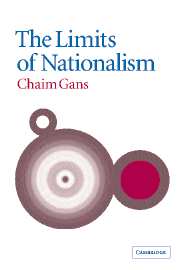Book contents
- Frontmatter
- Contents
- Acknowledgements
- Introduction
- 1 Nationalist ideologies – a normative typology
- 2 The liberal foundations of cultural nationalism
- 3 National self-determination
- 4 Historical rights and homelands
- 5 Nationalism and immigration
- 6 Nationalism, particularism and cosmopolitanism
- 7 Conclusion
- Bibliography
- Index
1 - Nationalist ideologies – a normative typology
Published online by Cambridge University Press: 22 September 2009
- Frontmatter
- Contents
- Acknowledgements
- Introduction
- 1 Nationalist ideologies – a normative typology
- 2 The liberal foundations of cultural nationalism
- 3 National self-determination
- 4 Historical rights and homelands
- 5 Nationalism and immigration
- 6 Nationalism, particularism and cosmopolitanism
- 7 Conclusion
- Bibliography
- Index
Summary
Cultural nationalism and statist nationalism
The terms ‘socialism’, ‘liberalism’ and ‘conservatism’ have been said to be ‘like surnames and the theories, principles and parties that share one of these names often do not have much more in common with one another than the members of a widely extended family’. The term ‘nationalism’ is even more complex, for it is the surname not only of one family of ideas, but of two. One family is that of statist nationalism. According to this type of nationalism, in order for states to realize political values such as democracy, economic welfare and distributive justice, the citizenries of states must share a homogeneous national culture. It must be noted that the values in question do not derive from specific national cultures. Nor are they aimed at their protection. The second family is that of cultural nationalism. According to this nationalism, members of groups sharing a common history and societal culture have a fundamental, morally significant interest in adhering to their culture and in sustaining it across generations. This interest warrants the protection of states. The two families of nationalism share a common name, and there are cases, as we shall see below, in which members of both families were or could have been happily married. Yet, their genealogies, at least their philosophical-normative genealogies, do not share one common origin. Within statist nationalism, the national culture is the means, and the values of the state are the aims.
- Type
- Chapter
- Information
- The Limits of Nationalism , pp. 7 - 38Publisher: Cambridge University PressPrint publication year: 2003
- 1
- Cited by

